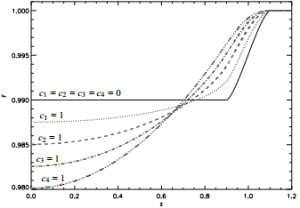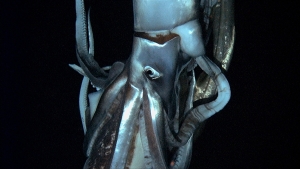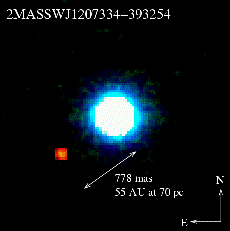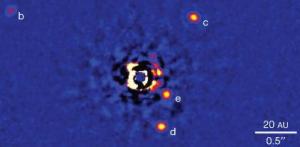
The Sun (Credit: NASA)
We looked at a simplistic understanding of planetary transits and transit light curves (here). In the interests of accuracy, it would be worth investigating a more formal understanding of the transit light curve. Specifically, this post will be aimed at actually modelling transit light curve while taking into account some more complicated dynamics such as limb darkening.
The actual shape of the transit light curve can be mathematically described by a function of the sky-projected centre-to-centre distance between the star and the planet, z, where z = 0 is understood to be the mid-transit of a centrally-crossing transit and the impact parameter, b is understood to be the minimum value of z throughout the transit, and the transit starts at about z ~ 1. More accurately, first and fourth contact start at , second and third contacts start at
. Furthermore, let’s define p as the ratio of the radii of the planet and the star,
.
Let us now define a function of the total fractional area of the star that is not obscured by the planet. Normally you might be inclined to feel that suffices, however it describes only the area ratio between second and third contacts, and is thus inadequate to describe the entire transit. We therefore will construct the amount of obscured stellar area as a piecewise function of p and z whose intervals describe different parts of the transit. It will be given as the ratio between the total area and the unobscured area subtracted away from the whole total area. Specifically,
.
Where and
. There’s a lot going on here but it isn’t too complicated to understand. The first case,
, describes when the planet is completely off the stellar disc, before first contact hence there is no (zero) obscured area. The second case is the most complicated and describes the time between first and second (third and fourth) contacts. The third case is what we covered earlier, where the amount of obscured area is simply the square of the ratio of their radii, and therefore simply
. The final case is only satisfied in the (unlikely) condition that the planet-to-star radius ratio > 1, and the entire area of the stellar disc is obscured.
Calculating z as a function of time may be done with knowledge of the impact parameter and use of Pythagorean theorem.
For a transiting planet with an impact parameter of zero and a radius ratio of (producing a 1% transit depth), the above model produces the following light curve plot.

Simulated Light Curve
Real light curves are actually curved, however, whereas this model is clearly much more “rigid” in shape. The reason for this is an effect known as limb darkening, where the outer layers of the star are not able to isometrically scatter light from underneath, causing less light from the limb of the star to reach the observer than from the centre of the stellar disc. For this reason, stars generally appear dimmer at their limbs and brighter in their centres. The magnitude of this difference will depend on a number of factors intrinsic to each star.
Proper handling of limb darkening will be required to obtain high-fidelity fits to high-accuracy data. A particularly popular and effective model for limb darkening was presented by Claret (2000). We can consider a four-parameter limb-darkening law describing the relative brightness of a point on the star expressed as a function of the angle between the observer, the centre of the star, and a line between the stellar centre and the given point on the star.
Where is given as
, and each value of c is called a “limb darkening coefficient.” In the case of the centre of the stellar disc,
. Each star will have a unique set of limb darkening coefficients, and they will change depending on what wavelength the transit is being observed in (due to how the properties of the stellar photosphere’s light scattering varies with wavelength). One could choose to have as many limb darkening parameters (and thus coefficients) as desired, but a high number is rarely required to adequately fit transit light curve data.
Limb darkening must be taken into account to get accurate measurements of radius ratios of transiting objects, and thus planetary radii. Because limb darkening will concentrate the brightness of the star into the centre of the disk, a planet that would cause a 1% transit depth in a uniformly bright star would cause a deeper transit depth in a central transit around limb-darkened star, and a shallower transit depth in a grazing transit around a limb-darkened star. Proper care in modelling the limb-darkening behaviour of the star is therefore required to ensure good measurement of the planetary radius.
We see therefore that the brightness difference is not a pure function of the ratio of the stellar and planetary radii. is only an approximation, and only correct for the unrealistic case of a uniformly bright stellar disc.
So what can we do to get a more comprehensive representation of a light curve? Let’s modify the equation for we’re familiar with and consider brightnesses instead of just purely area ratios. Let’s take our limb-darkening equation as the radius of the star and determine the area, since it describes the brightness of the star from centre to limb. With this equation as the stellar “radius,” we use some simple calculus to expand it to the “brightness area” of the circle that is the stellar disc. This calculates the total brightness of the star while taking into consideration the changing brightness behaviour from centre to limb. The actual transit depth of a planet at any given distance to the centre of the star (represented as z again) is simply the ratio of the total stellar brightness in the area of the star under the planet to the total brightness of the stellar disc. Therefore, we draft a new function based off our original understanding of
, while taking into effect the above model for how much of the star’s area is covered at any given time in the transit, as well as bringing in our limb-darkening model to describe the brightness distribution of the stellar disc:
And it makes quite a difference, too. By incorporating limb darkening coefficients, we’re able to much more accurately simulate the transit of a planet across a limb-darkened star. The diagram below shows the same planet (with p = 0.1) transiting stars of different limb-darkening parameters. The shape and modification to the transit depth is readily apparent.

Effects of Limb-Darkening coefficients


